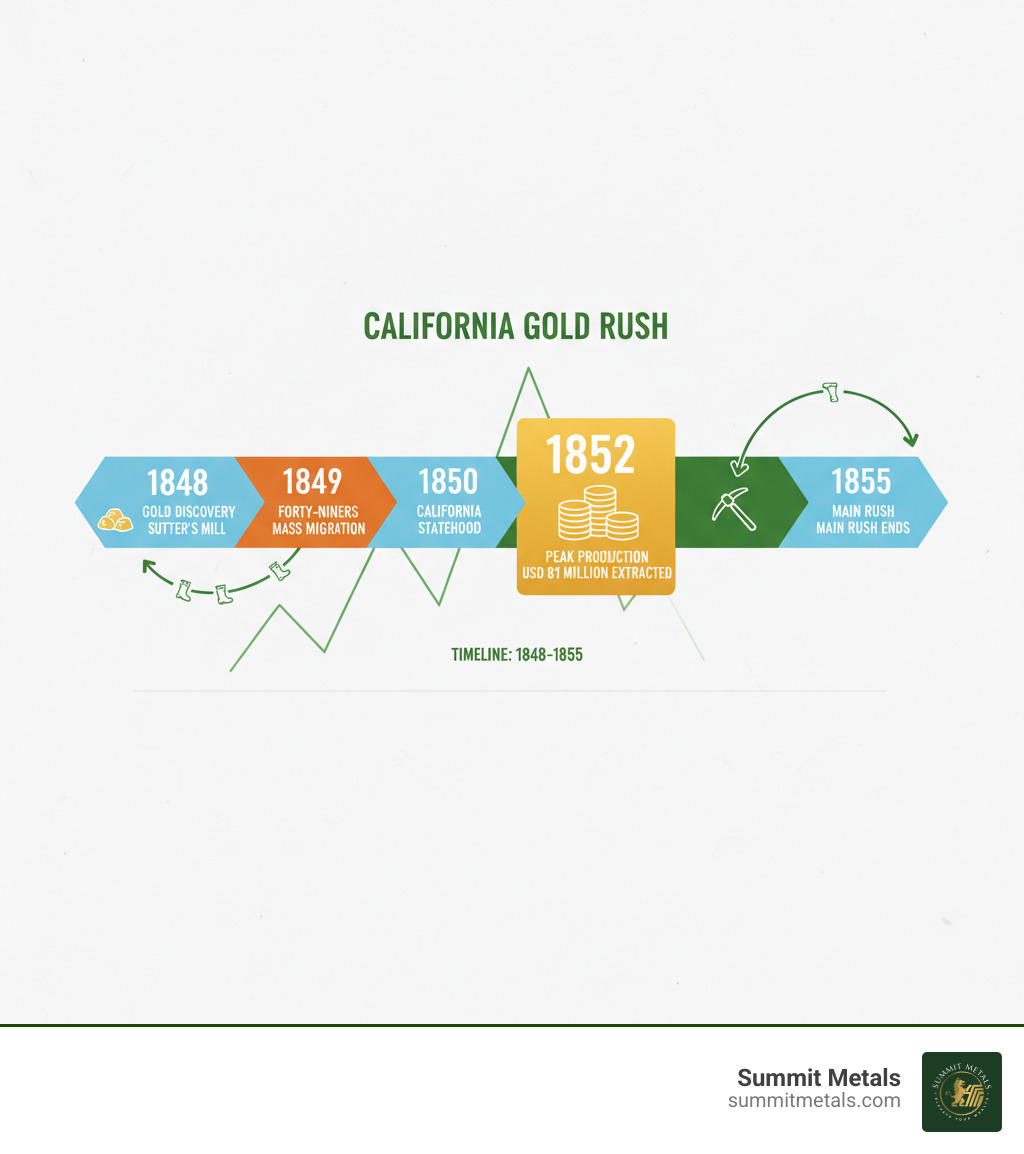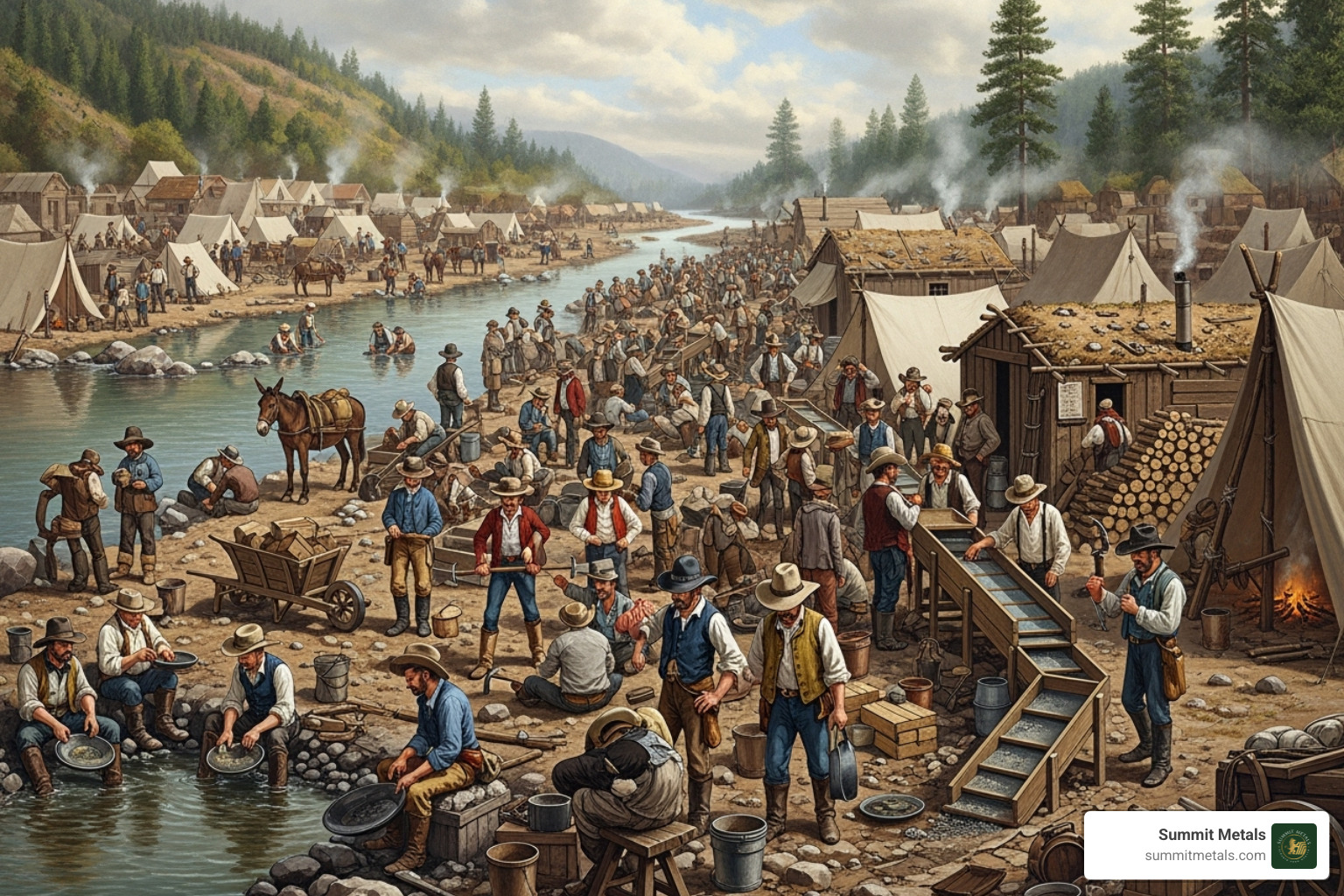The Day That Changed America Forever
When was the american gold rush? The California Gold Rush began on January 24, 1848, when James W. Marshall found gold flakes at Sutter's Mill along the American River. While the initial find happened in early 1848, the massive wave of fortune seekers—known as the "Forty-Niners"—arrived throughout 1849. The rush peaked in 1852 and officially ended around 1855.
Key Timeline:
- January 24, 1848 - Gold found at Sutter's Mill
- 1849 - Mass migration of 90,000 "Forty-Niners"
- 1850 - California achieves statehood
- 1852 - Peak gold production ($81 million extracted)
- 1855 - Main rush period ends as surface gold depletes
This findy triggered the largest migration in American history, with over 300,000 people flooding into California. The territory's non-native population exploded from 14,000 to 250,000 by 1852. The rush accelerated westward expansion, fueled America's economy, and reshaped the nation's identity. But it also brought harsh realities: brutal journeys, lawless mining camps, environmental damage, and the near-destruction of California's Native American population.
Understanding gold's historical value remains relevant today, especially for investors seeking to protect wealth. Just as the Forty-Niners saw gold as their path to security, modern investors turn to precious metals as a hedge against inflation.
I'm Eric Roach. My decade on Wall Street taught me that the principles driving those prospectors—scarcity, intrinsic value, and crisis resilience—make gold and silver essential to a balanced portfolio. Understanding when was the american gold rush reveals timeless truths about how precious metals preserve wealth, whether you're panning in a stream or building a portfolio through systematic investing.

The Spark: The Find That Ignited a Nation
On January 24, 1848, James W. Marshall was overseeing construction of a sawmill for his employer, John Sutter, along the American River near Coloma, California. While checking the millrace, he saw yellowish flecks glinting in the water. "It made my heart thump, for I was certain it was gold," he later recalled.
The Fateful Day at Sutter's Mill
Marshall and Sutter attempted to keep the find secret, knowing a rush of fortune-seekers would destroy Sutter's agricultural empire. Sutter tried to secure his land rights, but it was no use. Within months, his fields were trampled, his livestock scattered, and his workers had abandoned him for the goldfields. The man who owned the land where gold was found was bankrupt by 1852.
You can learn more about the official story of the gold discovery from the Library of Congress.
Spreading the Word: How "Gold Fever" Went Global
News of the find leaked slowly until San Francisco merchant Sam Brannan saw an opportunity. In May 1848, he strode through the city's streets waving a vial of gold dust, shouting "Gold! Gold! Gold from the American River!" His announcement turned speculation into certainty, and San Francisco emptied as men rushed to the mines.
The real explosion came on December 5, 1848, when President James K. Polk confirmed the gold find in his State of the Union address. This turned a regional rush into a global phenomenon. "Gold fever" spread across continents, drawing fortune-seekers known as "Argonauts" or "Forty-Niners" from Mexico, Chile, China, and Europe.
The routes they took were brutal: a six-month sail around Cape Horn, a disease-ridden crossing of the Isthmus of Panama, or a treacherous overland trek across the American continent. This international migration swelled California's non-native population from 14,000 in early 1848 to 250,000 by 1852.
Just as those prospectors saw gold as their path to security, modern investors recognize its value. The difference? Today, building a gold portfolio happens through systematic investing—like our Autoinvest feature, which allows you to dollar-cost average into precious metals without the hardships faced by the Forty-Niners.
The Definitive Timeline: When Was the American Gold Rush?
When was the american gold rush? While other gold finds occurred in American history, the California Gold Rush (1848–1855) was the defining event. Its scale, speed, and economic impact were transformative.
Understanding the timeline for when was the american gold rush
The Gold Rush unfolded in distinct phases:
1848 marked the beginning with Marshall's January 24 find. News traveled slowly, but by summer, a local rush was underway as people from Oregon, Hawaii, and other parts of California arrived. President Polk's December address fired the starting gun for a global race.
1849 became the legendary year of the "Forty-Niners." Approximately 90,000 people arrived, changing sleepy settlements into chaotic boomtowns filled with prospectors from around the world.
1850 brought statehood on September 9. The population boom fast-tracked California's admission to the Union as a free state under the Compromise of 1850, bypassing the typical territorial phase and intensifying the national debate over slavery.
1852 represented the peak, with gold production hitting an astounding $81 million (nearly $2 billion in modern terms). However, the easily accessible surface gold was disappearing.
By 1855, the rush was effectively over. Placer gold was depleted, and individual prospectors with pans and shovels were replaced by capital-intensive industrial mining operations.
Key dates for when was the american gold rush
Several historical moments shaped the Gold Rush era:
The Treaty of Guadalupe Hidalgo (February 2, 1848) ended the Mexican-American War just nine days after Marshall's find. Mexico ceded California to the U.S., unknowingly signing away a fortune.
The Compromise of 1850 was directly influenced by California's explosive growth, making its admission as a free state a key component of the legislative package.
The shift to industrial mining in the 1850s marked the end of the independent prospector. Large companies used heavy machinery like hydraulic cannons and hard-rock quartz mining, which required significant capital and wage labor.
In 1884, hydraulic mining was outlawed due to its devastating environmental impact. The practice choked rivers with sediment, destroyed farmland, and caused widespread flooding, leaving scars on the landscape that persist today.

Understanding this timeline helps us appreciate why gold has maintained its value. The Forty-Niners risked everything for gold because they understood its lasting worth—a principle that remains true for investors today who use precious metals to protect wealth from economic uncertainty.
Tools of the Trade: How Prospectors Hunted for Gold
The image of a lone prospector panning by a river captures only the beginning of the Gold Rush. As easy pickings disappeared, mining methods evolved from simple tools to industrial machinery, a shift that mirrors the benefit of using systematic strategies in modern investing.

From Pan to Sluice Box: Early Placer Mining
The first miners used placer mining to extract gold from loose riverbed sediments. Gold's high density caused it to settle at the bottom of streams.
Gold Panning: The simplest method. A miner would scoop gravel and water into a pan, swirling it to wash away lighter sand and leave heavy gold flakes behind. It was effective but slow and backbreaking.
Rockers (Cradles): A wooden box on rockers that could be operated by one or two people. Gravel was washed over a screen, and gold was caught in riffles at the bottom, processing more material than a pan.
Sluice Boxes: For groups, these long wooden troughs were even more efficient. Placed in a stream, water flowed through the box, washing away gravel while riffles trapped the gold. A good sluice could process large amounts of "pay dirt."
These early methods were relatively low-impact, but that changed as surface gold ran out.
The Rise of Industrial Mining and Its Consequences
By the early 1850s, getting to the remaining gold required capital, equipment, and destructive methods.
Hydraulic Mining: Developed in 1853, this method used high-pressure water cannons to blast away entire hillsides to get at gold-bearing gravel. While efficient, it caused catastrophic environmental damage, choking rivers with sediment and destroying farmland. It was largely outlawed in 1884.
Mercury Contamination: Miners finded that mercury (quicksilver) binds with fine gold particles, making them easier to recover. They would then heat the amalgam to burn off the mercury, leaving the gold. Unfortunately, much of this toxic mercury escaped into rivers and soil, creating a legacy of contamination that the U.S. Geological Survey reports persists today.
Quartz (Hard-Rock) Mining: As placer deposits were exhausted, miners turned to the source: gold trapped in quartz veins deep underground. This required digging shafts, blasting tunnels, and crushing the ore in loud, dangerous stamp mills. This shift marked the end of the independent prospector and the rise of corporate mining.
The evolution from panning to industrial mining shows that systematic approaches outperform random luck. Similarly, today's investors find that consistent, methodical investing is a more reliable path to building wealth than trying to time the market.
The Lasting Impact: How the Gold Rush Forged Modern California
The Gold Rush was a catalyst that permanently altered California, the American West, and the nation's identity. It sparked one of history's most dramatic social and economic upheavals.
A Demographic and Economic Revolution
The numbers are staggering. In early 1848, California's non-native population was just 14,000. By 1852, it had swelled to 250,000, and by 1855, over 300,000 people had arrived in the largest mass migration in U.S. history at the time. This influx included immigrants from China, Europe, and Latin America, creating a diverse, multicultural society.
The economic impact was immense. Gold production peaked at $81 million in 1852, with over $25 billion in modern dollars extracted by the turn of the century. This capital helped finance the transcontinental railroad and fueled America's industrial expansion. You can explore more about the economic history of the Gold Rush from EH.net.
San Francisco grew from a village of 800 to a city of 36,000 by 1852. The boom led to California's rapid statehood in 1850, cementing its future as an economic powerhouse.
The Dark Side of the Dream: Social and Environmental Costs
The promise of wealth had a devastating underside. The lack of an established legal system led to widespread lawlessness and vigilante justice in chaotic mining camps.
Discrimination was rampant. The Foreign Miners' Tax of 1850 targeted Chinese and Latin American miners, who also faced hostility and violence.
The most catastrophic impact fell on California's Native American population. Before 1848, 150,000 Native Americans lived in the region. By 1900, fewer than 20,000 survived. This decimation was the result of disease, starvation, and systematic violence now recognized by historians as the California Genocide. Miners destroyed traditional food sources, and the state government encouraged the extermination of native peoples.
Environmental destruction was also severe. Hydraulic mining washed away mountains, choked rivers with sediment, and poisoned waterways with mercury, leaving a toxic legacy that persists today.
Understanding when was the american gold rush requires acknowledging not just the economic boom but also these profound human and environmental costs that shaped modern California.
Frequently Asked Questions about the American Gold Rush
The California Gold Rush sparks curiosity about the realities faced by the Forty-Niners. Here are answers to some common questions.
What was the easiest way to get to California during the Gold Rush?
There was no "easy" way. Travelers chose between three perilous routes:
- By Sea Around Cape Horn: This was the longest route, taking five to eight months. It was expensive and involved navigating the violent storms at the southern tip of South America.
- The Panama Shortcut: A faster two-to-three-month journey. Travelers sailed to Panama, crossed the isthmus by land, and caught another ship on the Pacific side. The main danger was tropical diseases like cholera and yellow fever.
- Overland Routes: The most common choice, this 2,000-mile trek on trails like the California Trail took four to six months. Travelers in covered wagons faced disease, harsh weather, and scarce resources.
How much gold was found during the California Gold Rush?
An incredible amount. Between 1848 and 1855, miners extracted more than 750,000 pounds of gold. Production peaked in 1852 at $81 million—worth billions in today's money. This influx of wealth helped finance America's westward expansion and stabilized the national economy.
Did most prospectors get rich from the Gold Rush?
No, most prospectors did not strike it rich. The dream of instant wealth collided with a harsh reality. The high cost of living was a major factor; simple tools and food were sold at astronomical prices, consuming any gold a miner found. The work was physically brutal, and as more people arrived, the accessible gold quickly vanished.
The real fortunes were often made by merchants and entrepreneurs who sold supplies to the miners. Sam Brannan, who sold mining equipment, became California's first millionaire. This illustrates the "sell shovels in a gold rush" principle, which remains relevant today. For investors, this lesson highlights that a steady, systematic approach is more reliable than gambling on a lucky strike.
Conclusion: The Golden Legacy and Your Financial Future
The American Gold Rush was about more than gold; it was about hope, risk, and the creation of the "California Dream." It defined an era and shaped the identity of "The Golden State." You can still visit the Marshall Gold Discovery State Historic Park and stand where it all began, a powerful reminder of gold's symbolic and tangible value.
That fundamental truth—that gold holds intrinsic value through economic uncertainty—is what drove 300,000 people across the world. They endured incredible hardships because they believed in gold's power to secure their futures.
At Summit Metals, we make that same security accessible without the risk. Based in Wyoming, we provide authenticated gold and silver with transparent, real-time pricing. We believe you deserve to know exactly what you're paying—no hidden fees, just honest value.
Choosing the right form of precious metal is key. Government-minted gold coins and gold bars are both excellent options, but they serve different needs.
| Feature | Gold Coins (e.g., American Eagle) | Gold Bars |
|---|---|---|
| Premium | Higher premium over spot price | Lower premium over spot price |
| Authenticity | Government-guaranteed weight and purity | Stamped by private mints; rely on brand |
| Legal Tender | Have a face value, adding fraud protection | No face value |
| Divisibility | Available in smaller, easy-to-trade sizes | Best for large-volume purchases |
| Recognition | Globally recognized and easily liquidated | Highly liquid, but may require assay |
For those looking to build wealth systematically, our Autoinvest feature offers a modern solution. Instead of gambling on one big find, you can dollar-cost average into precious metals by buying a set amount each month, similar to a 401(k). This approach smooths out market fluctuations and builds your holdings steadily over time. You can create your own treasure without the hardships the Forty-Niners endured.
The prospectors who succeeded were often those who approached it systematically. That principle applies today. Whether you're protecting your retirement or diversifying your portfolio, precious metals offer the same security and confidence they did over 175 years ago.




